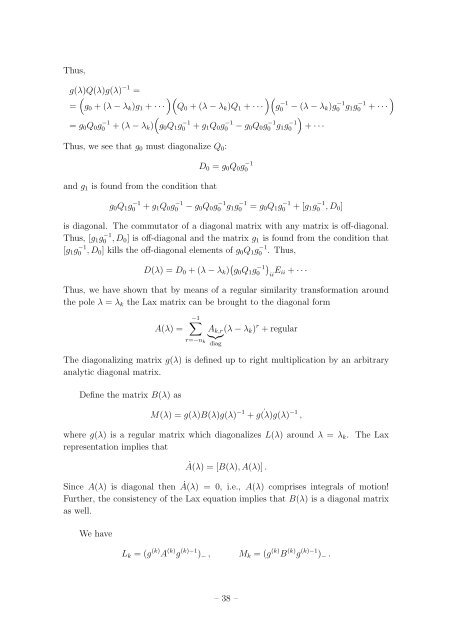Student Seminar: Classical and Quantum Integrable Systems
Student Seminar: Classical and Quantum Integrable Systems
Student Seminar: Classical and Quantum Integrable Systems
You also want an ePaper? Increase the reach of your titles
YUMPU automatically turns print PDFs into web optimized ePapers that Google loves.
Thus,<br />
g(λ)Q(λ)g(λ) −1 =<br />
(<br />
= g 0 + (λ − λ k )g 1 + · · ·<br />
(<br />
= g 0 Q 0 g0 −1 + (λ − λ k )<br />
Thus, we see that g 0 must diagonalize Q 0 :<br />
<strong>and</strong> g 1 is found from the condition that<br />
)(<br />
)(<br />
Q 0 + (λ − λ k )Q 1 + · · · g −1<br />
g 0 Q 1 g0 −1 + g 1 Q 0 g0 −1 − g 0 Q 0 g0 −1 g 1 g0<br />
−1<br />
D 0 = g 0 Q 0 g −1<br />
0<br />
)<br />
0 − (λ − λ k )g0 −1 g 1 g0 −1 + · · ·<br />
)<br />
+ · · ·<br />
g 0 Q 1 g −1<br />
0 + g 1 Q 0 g −1<br />
0 − g 0 Q 0 g −1<br />
0 g 1 g −1<br />
0 = g 0 Q 1 g −1<br />
0 + [g 1 g −1<br />
0 , D 0 ]<br />
is diagonal. The commutator of a diagonal matrix with any matrix is off-diagonal.<br />
Thus, [g 1 g0 −1 , D 0 ] is off-diagonal <strong>and</strong> the matrix g 1 is found from the condition that<br />
[g 1 g0 −1 , D 0 ] kills the off-diagonal elements of g 0 Q 1 g0 −1 . Thus,<br />
D(λ) = D 0 + (λ − λ k ) ( )<br />
g 0 Q 1 g0<br />
−1 E ii ii + · · ·<br />
Thus, we have shown that by means of a regular similarity transformation around<br />
the pole λ = λ k the Lax matrix can be brought to the diagonal form<br />
A(λ) =<br />
∑−1<br />
A<br />
}{{} k,r<br />
r=−n k diag<br />
(λ − λ k ) r + regular<br />
The diagonalizing matrix g(λ) is defined up to right multiplication by an arbitrary<br />
analytic diagonal matrix.<br />
Define the matrix B(λ) as<br />
M(λ) = g(λ)B(λ)g(λ) −1 +<br />
˙ g(λ)g(λ) −1 ,<br />
where g(λ) is a regular matrix which diagonalizes L(λ) around λ = λ k . The Lax<br />
representation implies that<br />
Ȧ(λ) = [B(λ), A(λ)] .<br />
Since A(λ) is diagonal then A(λ) ˙ = 0, i.e., A(λ) comprises integrals of motion!<br />
Further, the consistency of the Lax equation implies that B(λ) is a diagonal matrix<br />
as well.<br />
We have<br />
L k = (g (k) A (k) g (k)−1 ) − , M k = (g (k) B (k) g (k)−1 ) − .<br />
– 38 –

















